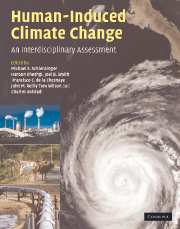Book contents
- Frontmatter
- Contents
- List of contributors
- Preface
- Part I Climate system science
- Part II Impacts and adaptation
- Part III Mitigation of greenhouse gases
- Part IV Policy design and decisionmaking under uncertainty
- 25 Climate policy design under uncertainty
- 26 Climate policy assessment using the Asia–Pacific Integrated Model
- 27 Price, quantity, and technology strategies for climate change policy
- 28 What is the economic value of information about climate thresholds?
- 29 Boiled frogs and path dependency in climate policy decisions
- 30 Article 2 and long-term climate stabilization: methods and models for decisionmaking under uncertainty
- 31 Whither integrated assessment? Reflections from the leading edge
- 32 Moving beyond concentrations: the challenge of limiting temperature change
- 33 International climate policy: approaches to policies and measures, and international coordination and cooperation
- Index
- Plate section
- References
30 - Article 2 and long-term climate stabilization: methods and models for decisionmaking under uncertainty
from Part IV - Policy design and decisionmaking under uncertainty
Published online by Cambridge University Press: 06 December 2010
- Frontmatter
- Contents
- List of contributors
- Preface
- Part I Climate system science
- Part II Impacts and adaptation
- Part III Mitigation of greenhouse gases
- Part IV Policy design and decisionmaking under uncertainty
- 25 Climate policy design under uncertainty
- 26 Climate policy assessment using the Asia–Pacific Integrated Model
- 27 Price, quantity, and technology strategies for climate change policy
- 28 What is the economic value of information about climate thresholds?
- 29 Boiled frogs and path dependency in climate policy decisions
- 30 Article 2 and long-term climate stabilization: methods and models for decisionmaking under uncertainty
- 31 Whither integrated assessment? Reflections from the leading edge
- 32 Moving beyond concentrations: the challenge of limiting temperature change
- 33 International climate policy: approaches to policies and measures, and international coordination and cooperation
- Index
- Plate section
- References
Summary
Introduction
The policy-oriented framing of the question about how much anthropogenic climate change the Earth's societies and ecosystems could endure is at least 20 years old. International conferences in Villach (Austria) in 1985 and 1987, and especially the one in Bellagio (Italy) in 1987, involved both scientists and policymakers in contemplating climate change and proposed that long-term environmental targets, such as the rates of global mean temperature increase or sea-level rise, should be used in policymaking (WCP, 1988). Referring to observed historical values, it was recommended to keep the rate of temperature increase below 0.1 °C per decade, based primarily on the estimated rate of ecological adaptation. This seemingly arbitrary proposition is rather specific compared with the riddle implied in the formulation of Article 2 about the ultimate objective of the United Nations Framework Convention on Climate Change (UNFCCC).
Article 2 of the UNFCCC frames the requirement for long-term climate policy in terms of an environmental objective “to prevent dangerous anthropogenic interference with the climate system.” This calls for “inverse approaches” that provide information about possible emission strategies with respect to externally specified environmental targets. Early attempts by Working Group I of the Intergovernmental Panel on Climate Change (IPCC, 1994a) and by Wigley et al. (1996) depict emission paths with respect to given CO2concentration targets.
- Type
- Chapter
- Information
- Human-Induced Climate ChangeAn Interdisciplinary Assessment, pp. 365 - 376Publisher: Cambridge University PressPrint publication year: 2007



